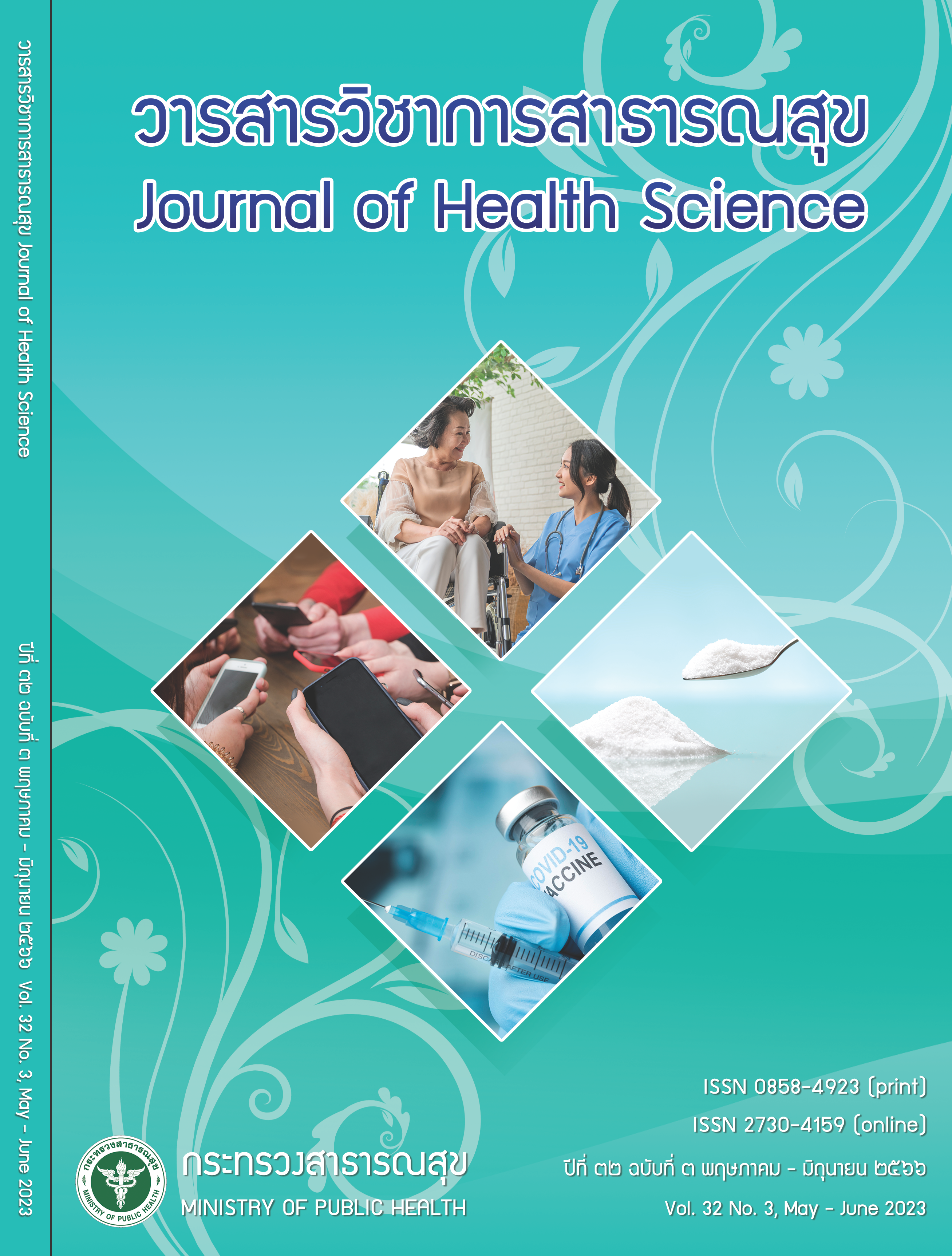Evaluating the Implementation of Drug Abuse Screening, Treatment and Rehabilitation for Abusers according to the Narcotics Bill B.E.2564 in 5 Selected Provinces in Thailand
Keywords:
screening, treatment, Narcotics Bill B.E. 2564, selected areasAbstract
This qualitative study aimed to examine the implementation related to drug abuse screening, treatment, rehabilitation, and social rehabilitation for abusers and explored the obstacle and supportive factors in 5 selected provinces. Collected data by using in depth interview and focus group. There were 44 key informants recruited with purposive sampling including professional staff from public health segments such as physicians, nurses, public health officers, social workers, psychologists and staff from interior segments and national policy agencies such as district clerks, polices, and community leaders who involved in implementation of treatment and rehabilitation for drug abusers according to the Narcotics Bill B.E. 2564 in the 5 selected provinces of Thailand including Narathiwat, Ubon Ratchathani, Mae Hong Son, Kanchanaburi, and Bangkok. Data were analyzed by using content analysis. It was found that after the enforcement of the new law, there were key findings in the 5 pilot provinces, which were categorized into 3 areas as follow: (1) inputs: integrated management, personal development, and selected area preparation, (2) process: transitional phase, active work, collaboration networks, and community based treatment (CBTx) implementation, and (3) outputs: establishing the screening centers by selecting sub-district health promoting hospitals where there were proper staff to implement the care service care, increase in the number of patients receiving care from re-X ray project, but the number of volunteer was low. Most provinces were on the process of setting up the social rehabilitation center except in Bangkok where the services were provided at district offices. The obstacle factors included limited understanding on the implementation of the new law; and the staff of sub-district health promoting hospitals did not feel convenient to refer and following up the abusers. In addition, coordinating between segments was almost absent. It is recommended that government agencies and civil societies be supported to register as screening and social rehabilitation centers covering every subdistrict and register to become case managers in order to cross-link among various segments including screening, treatment, and social rehabilitation for providing care services. In addition, e-learning courses should be developed to build capacity of professional staff to work in screening and social rehabilitation centers, and also work as case managers. Learning exchange forum should be established. Finally, local government organizations of each province should emphasize their roles to integrate the work between screening centers and social rehabilitation centers to implement CBTx in their areas.
Downloads
References
สำนักงานคณะกรรมการป้ องกันและปราบปรามยาเสพติด, กระทรวงยุติธรรม. แผนปฏิบัติการด้านการป้ องกันและปราบ ปรามยาเสพติด พ.ศ.2563-2565 [อินเทอร์เน็ต]. 2564 [สืบค้นเมื่อ 20 ธ.ค. 2565]. แหล่งข้อมูล: https://www. oncb.go.th/Home/PublishingImages/Pages/ProgramsandActivities
สำนักงานคณะกรรมการอาหารและยา, กระทรวงสาธารณสุข. ประมวลกฎหมายยาเสพติด พ.ศ. 2564 [อินเทอร์เน็ต]. 2564 [สืบค้นเมื่อ 20 ธ.ค. 2565]. แหล่งข้อมูลhttps:// mnfda.fda.moph.go.th/narcotic/wp-content/uploads/2021/11/Act_Narcotic64_091164.pdf
สำนักงานคณะกรรมการป้ องกันและปราบปรามยาเสพติด, กระทรวงยุติธรรม. ผลการปราบปรามยาเสพติดทั่วประเทศ รายงานประจำปี 2564 [อินเทอร์เน็ต]. 2564 [สืบค้นเมื่อ 20 ธ.ค. 2565]. แหล่งข้อมูล: https://www.oncb.go.th/ DocLib/ผลการปราบปรามยาเสพติดทั่วประเทศ%20ปี %202564.pdf
บุรฉัตร จันทร์แดง. บทวิเคราะห์สถานการณ์ปัญหายาเสพติดในปัจจุบัน. วารสารสถาบันวิจัยและพัฒนา มหาวิทยาลัยราชภัฏมหาสารคาม 2560;4(2):37-56.
ฉัตรชัย ศรีเมืองกาญจนา. ยาเสพติด: ปัญหาภัยแทรกซ้อน ในจังหวัดชายแดนภาคใต้ [อินเทอร์เน็ต]. 2564 [สืบค้นเมื่อ 20 ธ.ค. 2565]. แหล่งข้อมูล: https://www.parliament.go. th/ewtadmin/ewt/parliament_parcy/ewt_dl_link. php?nid=45110
สำนักงานเลขานุการคณะกรรมการบำบัดรักษาและฟื้ นฟูผู้ ติดยาเสพติด, กองบริหารการสาธารณสุข. แนวทางการดำเนินงานการบำบัดรักษาและฟื้นฟูสมรรถภาพผู้ติดยาเสพติดตามประมวลกฎหมายยาเสพติด [อินเทอร์เน็ต]. 2564 [สืบค้นเมื่อ 20 ธ.ค. 2565]. แหล่งข้อมูล: https:// phdb.moph.go.th/main/upload/ebook/web/2022050 2112432/mobile/index.html
ศูนย์อำนวยการป้ องกันและปราบปรามยาเสพติด กระทรวงสาธารณสุข. แผนยุทธศาสตร์ด้านการบำบัดรักษาและฟื้นฟูผู้ป่วยยาเสพติดประจำปีงบประมาณ พ.ศ. 2564 – 2566 [อินเทอร์เน็ต]. 2564 [สืบค้นเมื่อ 20 ธ.ค. 2565]. แหล่ง ข้อมูล: https://ncmc.moph.go.th/home/upload/web_ download/1doxcsiqctdwos4w4g.pdf
Michie S, Atkins L, West R. The behavior change wheel: a guide to designing interventions. London: Silverback Publishing; 2014.
สำนักงาน ปปส. กระทรวงยุติธรรม. ที่มาของนโยบายยาเสพติดแนวใหม่ “ผู้เสพ คือ ผู้ป่วย” [อินเทอร์เน็ต]. 2564 [สืบค้นเมื่อ 20 ธ.ค. 2565]. แหล่งข้อมูล: https://www. oncb.go.th/PublishingImages/Lists/ONCBNews1/AllItems/book-%20(1).pdf
ชรัส บุญณสะ. ปัญหาในการบูรณาการการแก้ไขปัญหายาเสพติดของผู้ว่าราชการจังหวัด. วารสารดำรงราชานุภาพ 2561;18(57):14-25.
ศศิวิมล คำเมือง, สระเกตุ ปานเถื่อน, ธีรดนย์ คงสิทธิ์ รัตนตระกูล. การศึกษาการมีส่วนร่วมของภาคประชาชนในการนำ นโยบายป้องกันและปราบปรามยาเสพติดไปสู่การปฏิบัติ กรณีศึกษา โครงการชุมชนยั่งยืนเพื่อแก้ไขปัญหายาเสพติด แบบครบวงจรตามยุทธศาสตร์ชาติ. สถาบันพัฒนาการเรียน รู้ศาสตร์สมัยใหม่ 2565;7(6):367-76.
กรมการแพทย์ กระทรวงสาธารณสุข. แนวทางการคัดกรอง การประเมินความรุนแรง การบำบัดรักษา การฟื้นฟูสมรรถภาพผู้ติดยาเสพติด สำหรับศูนย์คัดกรอง สถานพยาบาลยาเสพติด และสถานฟื้นฟูสมรรถภาพผู้ติดยาเสพติด ตามประมวลกฎหมายยาเสพติด [อินเทอร์เน็ต]. 2564 [สืบค้นเมื่อ 20 ธ.ค. 2565]. แหล่งข้อมูล: https:// drive.google.com/drive/folders/1X7Riv5ISDG9CuLdD8fEBlKE4xBX1qBeB
อัครพล คุรุศาสตรา, บรรณาธิการ. แนวทางการบำบัดฟื้นฟูผู้ใช้ยาเสพติดโดยใช้ชุมชนเป็นศูนย์กลาง. นนทบุรี: ศูนย์อำนวยการป้ องกันและปราบปรามยาเสพติด กระทรวงสาธารณสุข; 2561.
อาภาศิริ สุวรรณานนท์. การศึกษารูปแบบการดำเนินงานด้าน การบำบัดรักษาผู้ติดยาเสพติด. วารสารวิชาการบัณฑิตวิทยาลัยสวนดุสิต 2560;11(2): 213-222.
กุลนรี หาญพัฒนชัยกูร, เนาวรัตน์ เกษมพร, ภาสินี โทอินทร์, นวลละออง ทองโคตร. ปัจจัยที่มีผลต่อการบำบัดรักษายาเสพติดซ้ำของผู้ติดยาเสพติด. วารสารวิจัยทางวิทยาศาสตร์- สุขภาพ 2564;15(2):1-12.
อัครพล คุรุศาสตรา. การปฏิรูปด้านบำบัดฟื้ นฟูยาเสพติด แนวทางที่เหมาะสมสำหรับกระทรวงสาธารณสุข สำนักสถาน พยาบาลและการประกอบโรคศิลปะ. วารสารวิชาการกรม สนับสนุนบริการสุขภาพ 2562;15(2):6-10.
วนิตตา พิทยาเรืองนนท์, อารณีย์ วิวัฒนาภรณ์. ปัญหาในการบำบัดรักษาผู้ติดยาเสพติด: กรณีศึกษาในสถานพยาบาลของรัฐ. วารสารวิจัยธรรมศึกษา 2565;5(2):94-102.
ทิพรฎาร์ คุยแก้วพะเนาว์, ชนะพล ศรีฤาชา. คุณลักษณะส่วน บุคคลและปัจจัยทางการบริหารที่มีผลต่อการปฏิบัติงาน ป้องกันและแก้ไขปัญหายาเสพติดของเจ้าหน้าที่สาธารณสุข ในโรงพยาบาลส่งเสริมสุขภาพตำบล จังหวัดนครราชสีมา. วารสารวิจัยสาธารณสุขศาสตร์มหาวิทยาลัยขอนแก่น 2561; 11(4):47-57.
Downloads
Published
How to Cite
Issue
Section
License

This work is licensed under a Creative Commons Attribution-NonCommercial-NoDerivatives 4.0 International License.





